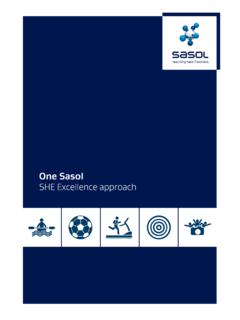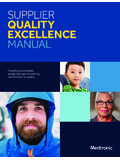Transcription of Commercial excellence in pharma 3
1 Commercial excellence in pharma Introduction The pharmaceutical industry is navigating a profound transformation. As markets shift rapidly, companies are scrambling to adapt their Commercial models for competitive advantage. The traditional pharma model, built on producing blockbuster drugs, has made way for a more diversified pharma model the quest to bring broader, more diversified product offerings to a more global market. At the same time that companies are evolving to pharma , they are already moving forward to the next phase of development, pharma At the center of this model are service components that enable companies to deliver health outcomes defined as (clinical and economic) health benefits per dollar spent. This shift represents a prime opportunity for the pharmaceutical industry to explore a variety of new business models focused on health outcomes, ranging from improving the performance of their current products on the market to tapping into new revenue streams associated with health care delivery.
2 pharma Today's pharmaceutical industry is facing strong headwinds. Cost containment initiatives by payers governments and health care insurance organizations alike have created a challenging business environment, with controlled pricing, promotion of cheaper generic alternatives, and greater obstacles to bringing innovative drugs to market. At the same time, the industry s investment in research and development is not providing the needed return on investment through more blockbuster drugs. For many years, these drugs broadly defined as primary care drugs with more than US$1 billion in revenue per year have been the centerpiece of the industry's successful business model that we call pharma Compounding these challenges, regulatory requirements to ensure drug safety have grown more stringent, bringing increased scrutiny of marketing practices and creating higher hurdles for reaching the market. To help alleviate these pressures, the industry has, over the past decade, followed a strategy of diversifying into a pharma model around product lines that are less exposed to R&D and market risks, such as generics, vaccines, over-the-counter medicines and medical technologies.
3 While this approach is helpful in the mid-term, long-term sustainability will require shifting to a new business model, one that will address the real needs of the industry's customers the patients, payers and physicians and contribute significantly to the ultimate goal: improving patient health. This requires shifting away from an arm's length approach, one that has centered on delivering drugs to the health care system. Instead, it calls for an up-close focus on the patient, providing products and services specifically designed for health improvement. This new degree of engagement is what we call pharma . In the pharma business model, which has been the topic in our two most recent reports on the pharmaceutical industry Progressions: pharma (2010) and Progressions: building pharma (2011) the industry will collaborate with other players, such as information technology companies, medical technology companies, food companies and retailers, to deliver patient-centric products and services.
4 Pharmaceutical companies around the world have started implementing these pharma patient-centric initiatives, mostly in the form of pilot projects. As of February 2011, we had already counted 220 such initiatives. These are collaborations and partnerships aimed at helping patients to manage their health, expand their access to products and services and address unmet medical challenges. Business models Multiple definitions of business model exist. We chose the definition used by Alexander Osterwalder in his book Business Model Generation: A business model describes the rationale of how an organization creates, delivers, and captures value.. The author uses a diagram comprising nine elements to describe business models and their transformation. Business model canvas Key partners Key activities Value proposition Customer relationships Customer segments CXOs R&D Physician Biotechs Marketing and sales Detailing Payer Non-traditional partners Connecting information Collaboration Drugs Communities +.
5 Multiple business models Patients Key resources Channels Health outcomes +. Physicians Vertically integrated Detailing Extraprise Engagement Cost structure Revenue streams Classical cost of goods sold Drug price x volume Shared, leveraged Health outcomes-based 1. Key partners: the network of suppliers 4. Value proposition: the bundle of 7. Customer segments: the different and partners that makes the business products and services that create groups of people or organizations an model work value for a specific customer segment enterprise aims to reach and serve 2. Key activities: the critical initiatives a 5. Customer relationships: the types of 8. Cost structure: all costs, such as company should undertake to make its relationships a company establishes marketing and promotion, business model work with specific customer segments distribution and royalty payments, incurred to operate a business model 3. Key resources: the essential 6. Channels: the way a company resources a company must have to communicates with and reaches its 9.
6 Revenue streams: represents the make its business model work customer segments to deliver a value cash a company generates from each proposition customer segment In this highly dynamic context, pharmaceutical Commercial organizations are under immense pressure. They must enable multiple business models, adapting their approaches to the market, with an evolving value proposition for numerous, rapidly changing stakeholders. As organizations understand what drives value for these market stakeholders and then vigorously align their value propositions and Commercial models to the changing drivers throughout the offering's life cycle they will achieve a fundamental goal: Commercial excellence . We have identified three critical components for Commercial excellence within pharma : Understanding what drives value: developing the ability to continuously identify, monitor and map the changing value drivers for diverse market stakeholders. Taking an agile approach to the market: providing a dynamic value proposition, through appropriate channels and optimal relationships, that meets changing demands along the offering's life cycle.
7 This involves enabling the interplay among business model development, market access and product launch around what drives value for individual stakeholders. Becoming an enabling organization: taking a customer-centric view, organized around market stakeholders, and learning in real time. Commercial excellence in pharma 1. Pharmaceutical Commercial universal access to health care. With low income per capita, the drug market in these countries today is primarily driven by cheaper excellence generics. However, rising income is making access to higher- priced branded medication possible, in turn requiring government intervention very often based upon price cuts, but also with Understanding what drives value emerging considerations around health outcomes. As pharmaceutical companies refine their current pharma Sophisticated health information technology is further enabling, and approaches to the market or build entirely new pharma business accelerating, an outcomes-driven industry.
8 Mobile health technology models, they need to do so in a highly stakeholder-centric way provides real-time access to digital health information, supporting diagnosis and monitoring as well as providing the opportunity to drive developing offerings that are not only economically viable but that patient adherence and compliance. Social media platforms enable also address the value requirements of their customers as well as the sharing of health information. The convergence of social media business partners. Then and continuously they must learn: learn and health information delivers the added benefit of empowering to identify, monitor and map these rapidly evolving drivers for their patients in health literacy, giving them access to information that in markets and stakeholders. the past was available only to their health care providers. Patients and their support groups are becoming super-consumers capable of making real, value-based decisions based on health outcomes while increasingly taking an important role in driving policy-making.
9 Sophisticated health information technology This tremendous expansion of available health data is empowering payers in their decision-making with the ability, for example, to is further enabling, and accelerating, an mine data as a basis for outcomes-based pricing and reimbursement outcomes-driven industry. Patients and schemes, and to assess a particular treatment's ultimate effectiveness within a real-world environment (as opposed to a tightly controlled their support groups are becoming super- study environment). consumers capable of making real, value- As the stakeholder landscape shifts, it also becomes increasingly based decisions based on health outcomes fragmented. Health care systems around the world are highly varied and have developed in diverse historical, economic or cultural while increasingly taking an important role in environments. driving policy-making. Furthermore, governments, faced with the complexity of managing health care systems at the national level, have often engaged in a devolution process, granting decision power for health care to local or regional governments.
10 Stakeholders Adding to this complexity, distribution systems vary widely across As changing market incentives are reshaping the health care countries, with wholesalers and pharmacies not only having a strong ecosystem, the stakeholder landscape for the pharmaceutical impact on how margins are distributed along the value chain but also industry is swiftly shifting as well. Payers and patients are increasingly having strong political power to influence policy-making. taking the lead in decision-making. Finally, in emerging markets, other considerations, such as In the pharma model, and within mature markets, making demanding investment in local manufacturing, directly or through decisions about what to buy or prescribe was traditionally the role alliances, often come into play and must be understood and reflected of primary care physicians. In the more diversified pharma in Commercial strategy. model, decision-making increasingly includes payers and patients.













